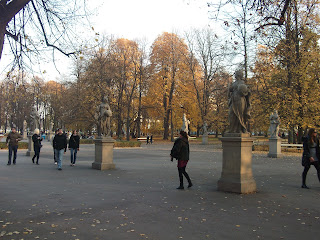The main LDS chapel in Warsaw sits between 2 large cemeteries on the west side of the city. The walkway between the cemeteries goes right through the churchyard. The missionaries took advantage of the opportunity of so many passing the church, to share the gospel with them. They stood in front of the church from morning until 7 or 8 at night passing out fliers and talking about the church. The gave tours and taught several discussions. The mission president and his wife were there and also participated in the singing of hymns and talking with passersby. I ran into President Nielsen and his wife at the 1944 Uprising monument at the cemetery. Because there are no stakes yet in Poland, President Nielsen, as the mission president, is really the president of the church in this country. He is a great man.
When the sun went down, which happens very early now, around 4pm, the cemetery was lit up by all the candles on the tombs. It was very beautiful.
This is one of the oldest public gardens in the world. There used to be a large castle on the east side of the garden. Like most of Warsaw, it was leveled during WWII. In it's place is the tomb of the Unknown Soldiers.
Next to the tomb was a really cool park bench, one in a series, that is dedicated to a bit of Chopin history. Each of them tell a little bit of Chopin history and play some of his music.
On the far side of the open complex where the castle used to stand, is a large cross. This marks the spot where Pope John Paul II (who was Polish) came during the cold war and prophesied that communism would one day fall and Poland would be a much happier place to live. That certainly came true.
Standing in the same place and turning to the north, I took this next picture. It is the back of the National Grand Opera house.
This too was almost completely destroyed during WWII (85% of Warsaw was destroyed). It was rebuilt after the war and reopened in 1965. It was the largest opera house in Europe at the time. Here is the front of the building.
Out front of the theater is a statue of Polands greatest opera composer, Stanisłow Moniuszko (pr. Staneeswov Moniushkoh).
Down the road fron the opera house are several other Chopin benches and the church where his heart is buried. He died in France, but his heart was brought back to Warsaw and buried in the Church of the Holy Cross.
It was a fun afternoon. All of these places are within a mile from my apartment.
More next week.




























What an amazing place full of so much diverse history!
ReplyDelete